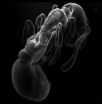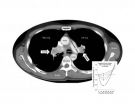(Press-News.org) A minimally invasive procedure to remove blood clots in brain tissue after hemorrhagic stroke appears safe and may also reduce long-term disability, according to late-breaking research presented at the American Stroke Association's International Stroke Conference 2013.
Of the hundreds of thousands of Americans who have intracerebral hemorrhages (ICH) each year, most are severely debilitated, said Daniel Hanley, M.D., lead author and professor of neurology at Johns Hopkins School of Medicine in Baltimore, Md.
ICH is the most common type of bleeding stroke. It occurs when a weakened blood vessel inside the brain ruptures and leaks blood into surrounding brain tissue, causing neurological damage. There is not a specific evidence-based targeted treatment recommended for ICH and there is no long-term randomized data on surgical treatment.
In one-year results of the Phase II study, MISTIE (Minimally Invasive Surgery plus rtPA for Intracerebral Hemorrhage Evacuation), researchers found that patients treated with surgery and a clot- busting drug had less disability, spent less time in the hospital and were less likely to be in a long-term care facility than other ICH patients.
"There is now real hope we have a treatment for the last form of stroke that doesn't have a treatment — brain hemorrhage," said Hanley, who is also director of the Brain Injury Outcomes Division at Johns Hopkins.
The overall study involved 96 patients at 26 hospitals who had a bleeding stroke. The stage two arm of the trial focused on 25 patients who had the surgical procedure and 31 who were given standard post-stroke medical care, which is medical management only. Patients were average age 60 and 75 percent were men.
During the treatment, surgeons cut a hole the size of a dime in the patient's skull. A catheter is passed into the brain tissue, pushing it through the longest part of the clot, which has formed from blood that pooled during the stroke. Next they apply the clot-busting drug recombinant tissue plasminogen activator (rtPA) to the clot via the catheter every eight hours for about three days. As the clot liquefies, it is removed through the catheter.
The study's patients had blood clots with an average volume of 46 milliliters, about the size of a golf ball, Hanley said. The procedure removed 57 percent of the clots on average, while clots naturally dissolved in only about 5 percent in the standard medical care group in the few days after stroke.
"The normal healing processes may be occurring more rapidly when you remove the blood," Hanley said. "We believe we're actually stopping brain injury and preserving brain tissue that would otherwise be lost."
Researchers found less fluid buildup (edema) in the brains of the surgical patients four days after the procedure, compared with the usual care group.
In six-month results presented last year, researchers noted that the surgical group had 11 percent better functional outcomes. The newest findings showed that a year after the stroke, the advantage in the surgery group had increased to 14 percent.
Likewise, yearlong results among patients with mild disability also showed a 14 percent difference between the treatment groups. Again, more patients from the surgical group improved during that time frame. And compared with the usual care group, 14 percent fewer of the surgical patients were in long-term care a year later.
"That 14 percent shift is occurring across the spectrum — from long-term care to moderate disability to mild disability," Hanley said.
For patients who underwent the surgical procedure, median time spent in any level of hospital or rehabilitation care was 38 days shorter than for the usual care group. That difference could represent a cost savings per patient of more than $44,000, the researchers estimated.
Researchers noted that no hemorrhage was too large or too deep in the brain to be helped by the procedure. Patients who had surgery between 36 and 72 hours after their stroke fared as well as those treated sooner. Women as well as men, blacks as well as whites, and people over and under age 65 appeared to benefit equally, although a larger study is needed to validate the findings. The researchers hope next to conduct a 500-patient Phase III study at more than 75 sites.
Hanley said the training for surgeons is simple and the equipment is readily available. If the MISTIE findings are confirmed, "then we have a practical treatment that can easily be done by all trained neurosurgeons," he said. "It could make a substantial difference in this disease."
###
The study was completed as a cooperative program with Mario Zuccarello University of Cincinnati as the surgical leader and co-principle investigator. A full list of co-authors and author disclosures is available on the abstract. The National Institute of Neurological Disorders and Stroke funded the research; Genentech provided the rt-PA drug, Alteplase®.
Follow news from the ASA International Stroke Conference 2013 via Twitter @HeartNews; #ISC13.
Statements and conclusions of study authors that are presented at American Stroke Association scientific meetings are solely those of the study authors and do not necessarily reflect association policy or position. The association makes no representation or warranty as to their accuracy or reliability. The association receives funding primarily from individuals; foundations and corporations (including pharmaceutical, device manufacturers and other companies) also make donations and fund specific association programs and events. The association has strict policies to prevent these relationships from influencing the science content. Revenues from pharmaceutical and device corporations are available at www.heart.org/corporatefunding.
Note: Actual presentation is 12:30 p.m. HT, Thursday, Feb. 7, 2013.
All downloadable video/audio interviews, B-roll, animation and images related to this news release are located on the right column of the release link. Video clips with researchers/authors of studies will be added to the release links after embargo.
Surgical procedure appears to improve outcomes after bleeding stroke
Abstract: LB1
2013-02-07
ELSE PRESS RELEASES FROM THIS DATE:
Southern diet could raise your risk of stroke
2013-02-07
Eating Southern-style foods may be linked to a higher risk of stroke, according to research presented at the American Stroke Association's International Stroke Conference 2013.
In the first large-scale study on the relationship between Southern foods and stroke, researchers characterized a Southern diet by a high intake of foods such as fried chicken, fried fish, fried potatoes, bacon, ham, liver and gizzards, and sugary drinks such as sweet tea. In addition to being high in fat, fried foods tend to be heavily salted.
"We've got three major factors working together in ...
Almost 8 percent of US stroke survivors may have suicidal thoughts
2013-02-07
Nearly one in 12 American stroke survivors may have contemplated suicide or wished themselves dead, according to a study presented at the American Stroke Association's International Stroke Conference 2013.
The proportion of stroke survivors who contemplated suicide was striking, compared with patients with other health conditions, said Amytis Towfighi, M.D., lead author of the study and an assistant professor of Clinical Neurology at the University of Southern California in Los Angeles and chair of the Department of Neurology at Rancho Los Amigos National Rehabilitation ...
Infant, child stroke survivors prone to seizures, epilepsy
2013-02-07
About one-third of American infants and children who suffer bleeding into brain tissue, may later have seizures and as many as 13 percent will develop epilepsy within two years, according to new research reported at the American Stroke Association's International Stroke Conference 2013.
Bleeding into brain tissue is a type of stroke called intracerebral hemorrhage (ICH). Each year, an estimated 6.4 newborns and children per every 100,000 in the United States suffer strokes. About half of the strokes are hemorrhagic, typically caused by rupturing of weakened or malformed ...
Some stroke patients whose life support is withdrawn may have achieved a less-than-ideal
2013-02-07
More than a third of patients who suffer a major bleeding in the brain and have their life support withdrawn might have eventually regained an acceptable level of functioning if life support had been sustained, suggests a new study presented at the American Stroke Association's International Stroke Conference 2013.
In the United States, 10 percent of the estimated 795,000 strokes each year are intracerebral hemorrhages (ICH). ICH is the most common type of bleeding stroke and it occurs when a weakened blood vessel inside the brain ruptures and leaks blood into surrounding ...
Magnetic map guides salmon home
2013-02-07
For sockeye salmon coming home after years spent at sea, a magnetic map is apparently responsible for their remarkable sense of direction. That's according to an analysis of data collected over 56 years and reported online on February 7 in Current Biology, a Cell Press publication.
"To find their way back home across thousands of kilometers of ocean, salmon imprint on the magnetic field that exists where they first enter the sea as juveniles," said Nathan Putman of Oregon State University. "Upon reaching maturity, they seek the coastal location with the same magnetic ...
For ant pupae, status means being heard
2013-02-07
AUDIO:
This is a recording of ant pupa sound.
Click here for more information.
For young ants at the pupal stage of life—caught between larva and adulthood—status is all about being heard. The findings, reported online on February 7 in Current Biology, a Cell Press publication, add to evidence that ants can communicate abstract information through sound in addition to chemical cues.
"One of the truly fascinating characteristics of social insects is their power of self-organization, ...
Researchers identify potential target for age-related cognitive decline
2013-02-07
As the elderly age, their ability to concentrate, reason, and recall facts tends to decline in part because their brains generate fewer new neurons than they did when they were younger. Now, researchers reporting in the February 7th issue of the Cell Press journal Cell Stem Cell have discovered a molecule that accumulates with age and inhibits the formation of new neurons. The finding might help scientists design therapies to prevent age-related cognitive decline.
The investigators identified the molecule, called Dickkopf-1 or Dkk1, in the brains of aged mice. By blocking ...
Reassuring evidence: Anticancer drug does not accelerate tumor growth after treatment ends
2013-02-07
Studies in animals have raised concerns that tumors may grow faster after the anticancer drug sunitinib is discontinued. But oncologists and physicists who collaborated to analyze data from the largest study of patients with kidney cancer convincingly demonstrate that such tumor acceleration does not occur in humans. The findings, publishing online on February 7th in the Cell Press journal Cell Reports, suggest that sunitinib does not cause lingering risks for patients after their treatment ends.
"We were able to demonstrate that this applied across all patients and that ...
Hopkins researchers uncover key to antidepressant response
2013-02-07
Through a series of investigations in mice and humans, Johns Hopkins researchers have identified a protein that appears to be the target of both antidepressant drugs and electroconvulsive therapy. Results of their experiments explain how these therapies likely work to relieve depression by stimulating stem cells in the brain to grow and mature. In addition, the researchers say, these experiments raise the possibility of predicting individual people's response to depression therapy, and fine-tuning treatment accordingly. Reports on separate aspects of the research were published ...
Treatment with clot-busting drug yields better results after stroke than supportive therapy alone
2013-02-07
In an update to previous research, Johns Hopkins neurologists say minimally invasive delivery of the drug tPA directly into potentially lethal blood clots in the brain helped more patients function independently a year after suffering an intracerebral hemorrhage (ICH), a deadly and debilitating form of stroke. Rates of functional recovery with the active tPA treatment far surpassed those achieved with standard "supportive" therapy that essentially gives clots a chance to shrink on their own.
In the current Johns Hopkins-led study, ICH patients who randomly received the ...
LAST 30 PRESS RELEASES:
Norbert Holtkamp appointed director of Fermi National Accelerator Laboratory
New agentic AI platform accelerates advanced optics design
Biologists discover neurons use physical signals — not electricity — to stabilize communication
Researchers discover that a hormone can access the brain by hitchhiking
University of Oklahoma researcher awarded funding to pursue AI-powered material design
Exploring how the visual system recovers following injury
Support for parents with infants at pediatric check-ups leads to better reading and math skills in elementary school
Kids’ behavioral health is a growing share of family health costs
Day & night: Cancer disrupts the brain’s natural rhythm
COVID-19 vaccination significantly reduces risk to pregnant women and baby
The role of vaccination in maternal and perinatal outcomes associated with COVID-19 in pregnancy
Mayo Clinic smartwatch system helps parents shorten and defuse children's severe tantrums early
Behavioral health spending spikes to 40% of all children’s health expenditures, nearly doubling in a decade
Digital cognitive behavioral treatment for generalized anxiety disorder
Expenditures for pediatric behavioral health care over time and estimated family financial burden
Air conditioning in nursing homes and mortality during extreme heat
The Alps to lose a record number of glaciers in the next decade
What makes a good proton conductor?
New science reporting guide published for journalists in Bulgaria
New international study reveals major survival gaps among children with cancer
New science reporting guide published for journalists in Turkey
Scientists develop a smarter mRNA therapy that knows which cells to target
Neuroanatomy-informed brain–machine hybrid intelligence for robust acoustic target detection
Eight SwRI hydrogen projects funded by ENERGYWERX
The Lundquist Institute and its start-up company Vitalex Biosciences Announces Strategic Advancement of Second-Generation fungal Vaccine VXV-01 through Phase 1 Trials under $40 Million Competitive Con
Fine particles in pollution are associated with early signs of autoimmune disease
Review article | Towards a Global Ground-Based Earth Observatory (GGBEO): Leveraging existing systems and networks
Penn and UMich create world’s smallest programmable, autonomous robots
Cleveland researchers launch first major study to address ‘hidden performance killer’ in athletes
To connect across politics, try saying what you oppose
[Press-News.org] Surgical procedure appears to improve outcomes after bleeding strokeAbstract: LB1



